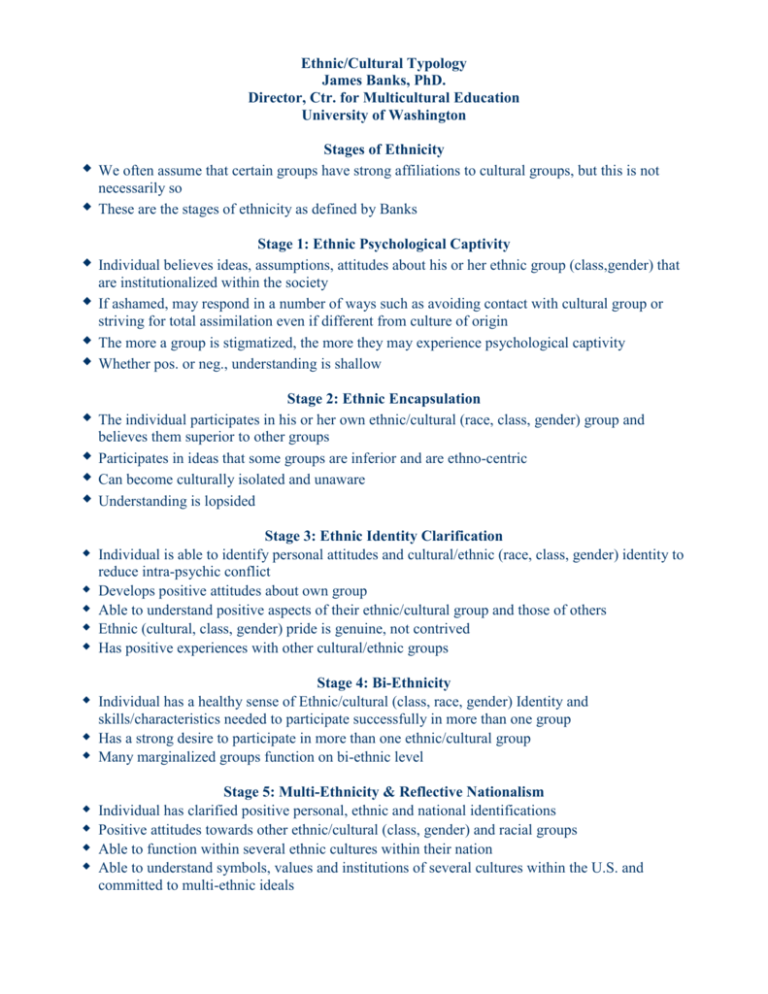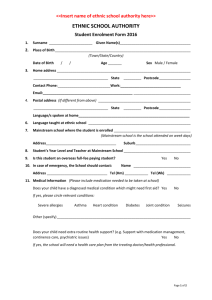Ethnic/Cultural Typology - University of Washington
advertisement

Ethnic/Cultural Typology James Banks, PhD. Director, Ctr. for Multicultural Education University of Washington Stages of Ethnicity We often assume that certain groups have strong affiliations to cultural groups, but this is not necessarily so These are the stages of ethnicity as defined by Banks Stage 1: Ethnic Psychological Captivity Individual believes ideas, assumptions, attitudes about his or her ethnic group (class,gender) that are institutionalized within the society If ashamed, may respond in a number of ways such as avoiding contact with cultural group or striving for total assimilation even if different from culture of origin The more a group is stigmatized, the more they may experience psychological captivity Whether pos. or neg., understanding is shallow Stage 2: Ethnic Encapsulation The individual participates in his or her own ethnic/cultural (race, class, gender) group and believes them superior to other groups Participates in ideas that some groups are inferior and are ethno-centric Can become culturally isolated and unaware Understanding is lopsided Stage 3: Ethnic Identity Clarification Individual is able to identify personal attitudes and cultural/ethnic (race, class, gender) identity to reduce intra-psychic conflict Develops positive attitudes about own group Able to understand positive aspects of their ethnic/cultural group and those of others Ethnic (cultural, class, gender) pride is genuine, not contrived Has positive experiences with other cultural/ethnic groups Stage 4: Bi-Ethnicity Individual has a healthy sense of Ethnic/cultural (class, race, gender) Identity and skills/characteristics needed to participate successfully in more than one group Has a strong desire to participate in more than one ethnic/cultural group Many marginalized groups function on bi-ethnic level Stage 5: Multi-Ethnicity & Reflective Nationalism Individual has clarified positive personal, ethnic and national identifications Positive attitudes towards other ethnic/cultural (class, gender) and racial groups Able to function within several ethnic cultures within their nation Able to understand symbols, values and institutions of several cultures within the U.S. and committed to multi-ethnic ideals • • • • Stage 6: Globalism and Global Competency All of stage 5 as well as ability to function within cultures in other parts of the world Ideal balance of ethnic/cultural (gender, class, race), national and global identifications, commitments, literacy and behaviors Has internalized universalistic ethical values and principles of humankind and has the competencies and skills needed to take action within the world to actualize commitments Typology Characteristics Within each stage there are variations of awareness Divisions between stages is blurred Transitions are gradual May go up, down zig zag or across from one stage to another Implications for Curriculum Stage 1: Benefits from exposure to own ethnic/cultural group perspectives and info Stage 2: Benefits from learning about other ethnic/cultural groups and perspectives Stage 3: Benefits from support of emerging ethnic/cultural awareness and opinion Stage 4: Should help students understand other ethnic/cultural groups other than their own Stage 5: Should help students develop a global sense of ethnic/cultural literacy and to master concepts about a large range of groups within U.S. Stage 6: Helps students function more effectively in being global agents of change and in understanding global issues Levels of Multi-Cultural Awareness Contributions Level (adding ethnic weeks, gives minimal visibility to diversity) The Ethnic Additive Level (gives info on diversity from outsider or dominant point of view, but not original) The Transformative Level (challenges basic assumptions, provides more than one point of view) The Decision-Making and Social Action Level (encourage taking social action to change/improve society or injustice) Discussion How do you think I.M. has or will change in terms of his own inner Ethnic Awareness or Psychology? Provide text (page#) that shows what you decide. Come up with a solid example that illustrates a Multi-Cultural Level that exist in your own environment or in society in general. For instance, in terms of Level 3, many utility companies have instructions in both Spanish & English to reach non-native speakers. This refutes the assumption that we have only one language (English) in this country.







